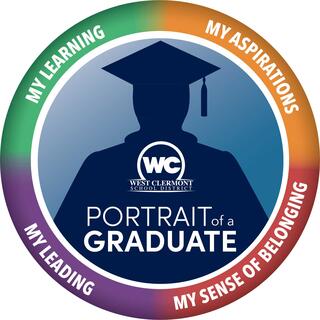
by Natasha L. Adams, Superintendent & CEO
West Clermont Schools
Our student-centered learning model includes a systematic approach to meeting the needs of the whole child:

- LEARN: Participate in challenging, meaningful learning experiences
- ASPIRE: Assess their own talents and aspirations
- LEAD: Plan a pathway toward their own purpose
- BELONG: Feel cared for and connected as they work collaboratively with the support of teachers, adult mentors and guides
To better understand this vision we must start by highlighting the essential role of the educator. In student-centered learning, educators believe all students can learn and know that by working collaboratively with their colleagues they are the people who can make it happen! They take responsibility for building relationships with students by knowing their name, story, strengths and needs. They hold high expectations for themselves to engage, empower and challenge every student. The modern role of the educator shifts beyond being the person who brings content knowledge to the classroom to more of a “coach” leading each student through their own learning journey.
Meaningful learning is possible when educators collaborate to foster deeper learning—the kind of learning that yields Portrait of a Graduate attributes like academic & life skills, communication & collaboration, character & integrity, innovative & creative thinking, resilience & adaptability. This kind of learning is usually characterized by being performance-based, involving cross-curricular connections, and is often rooted in the local and global community beyond the walls of the classroom. Deeper learning gives students a chance to go further into the curriculum and complete in-depth studies that require them to blend foundational knowledge and skills with complex thinking with the ultimate goal of being able to transfer that knowledge and learning to new experiences. Learning like this requires educators to move away from traditional ways of working in isolation to a more collaborative approach to learning.
Working with students in these newer ways to blend foundational knowledge and skills with complex, deeper learning skills will require our teachers to learn how to blend their proven instructional strategies such as cooperative groups, graphic organizers, and problem-based learning with the new, more innovative practices such as blended learning, e-portfolios, digital story-telling, authentic/relevant/community-based learning, etc.
Another key piece of our student-centered instructional framework is the “third” teacher in the room. This third teacher is the learning environment itself. Modern classrooms have flexible furniture, opportunities for independent work, small group and whole class learning, and a robust set of technology tools to explore and use to connect with others. In addition to classrooms looking and functioning beyond the traditional rows and columns approach, in student-centered learning the definition of classroom gets expanded. A modern school system aims to provide a variety of learning pathways to every student, some classroom-embedded, some co-curricular, and some outside-of-the-school walls. For this approach to work well, the community has to become a human library for our students to explore.
Our goal is to provide strong teaching in every classroom through our student-centered instructional approach. We know we are achieving our goals when our school leaders can communicate a clear instructional vision and monitor instructional practices, and we continue to support our teachers in ways that allow them to enhance their skills and collaboration opportunities.
Stay tuned! To provide clarity and ensure a singular vision for the district, a team of West Clermont educators is building upon our current instructional frameworks. The goal is to provide direction on how to blend strategies for foundational knowledge and skills with strategies for deeper-learning so that we can reach Portrait of a Graduate outcomes for all students. This process will be complete later this fall, at which time principals and instructional coaches will work with staff to upskill so we can make this important shift.




